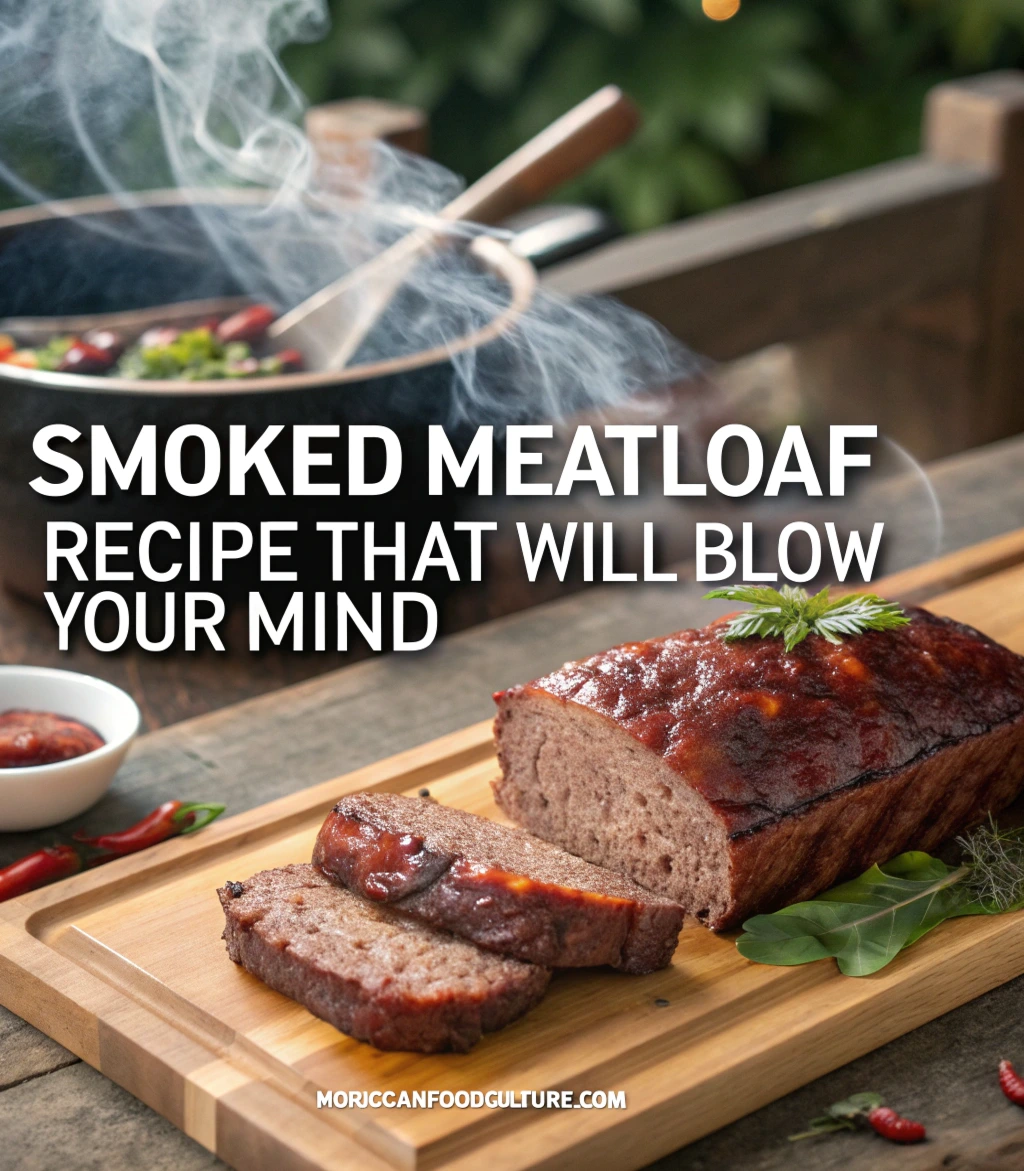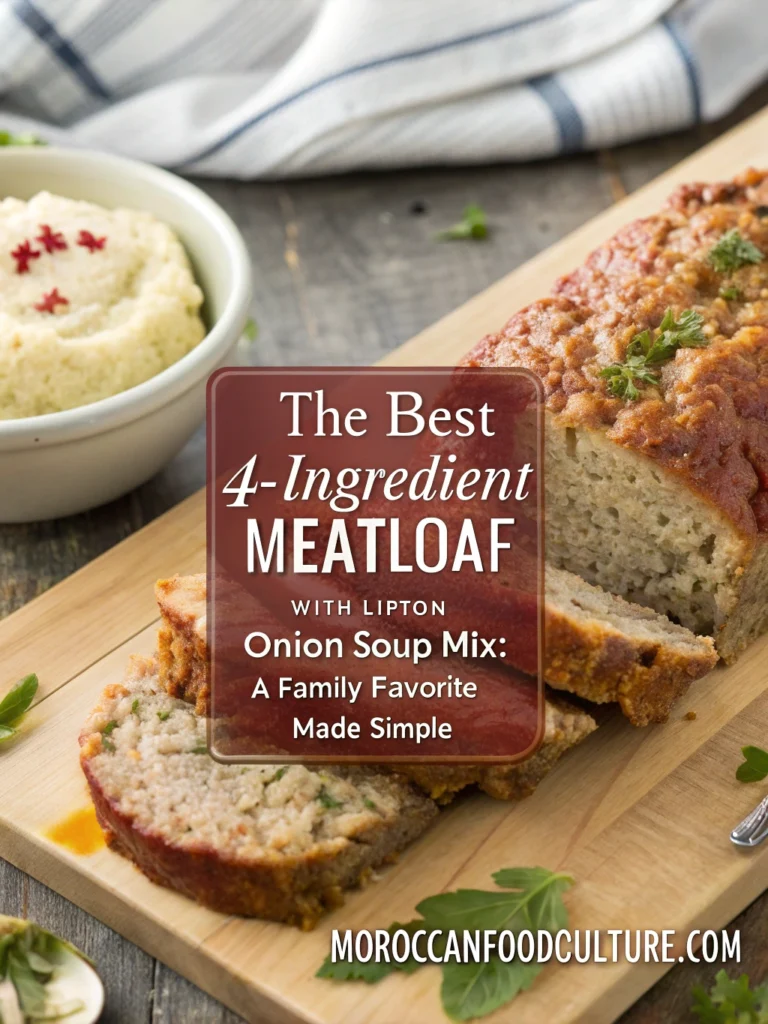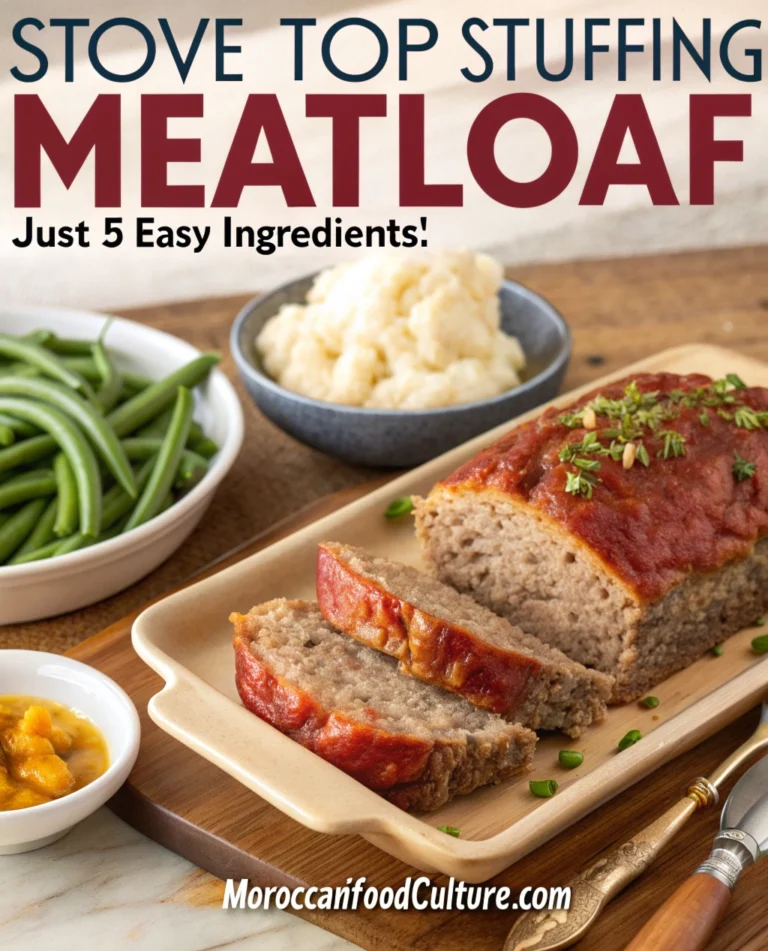Smoked Meatloaf Recipe That Will Blow Your Mind
Introduction: Reinventing a Classic Comfort Food
Growing up in the heartland, Sunday dinners at my grandparents’ farm always featured the same centerpiece: a classic meatloaf that appeared like clockwork alongside mashed potatoes and green beans. While I treasured those meals, it wasn’t until years later—standing beside my smoker on a crisp autumn afternoon—that I discovered meatloaf’s untapped potential.
The first time I pulled a perfectly smoked meatloaf from my backyard smoker, the rich aroma filling the air and the beautiful mahogany exterior glistening with a sweet-savory glaze, I knew I could never go back to oven-baked. That transformative moment changed my understanding of what this humble dish could become.
This smoked meatloaf recipe doesn’t just update a classic—it revolutionizes it, creating something so flavorful and unique that your first bite will quite literally blow your mind. Whether you’re a smoking enthusiast or a curious novice, prepare to elevate this American comfort food staple into something extraordinary.
Table of Contents

Why Smoking Transforms Ordinary Meatloaf
Ever wondered why food from a smoker tastes so remarkably different? The transformation isn’t just perception—it’s science.
The Science Behind Smoked Meatloaf
When you cook meatloaf in a smoker rather than an oven, several fascinating processes occur simultaneously:
- Slow smoking allows fat to render gradually, creating unparalleled juiciness throughout the meat
- Smoke molecules bond with proteins in the meat, forming the coveted pink “smoke ring” and distinctive flavor
- Lower cooking temperatures prevent moisture loss that often plagues oven-baked versions
- Wood flavor compounds infuse throughout the meat during the extended cooking process
The result isn’t just meatloaf with added smokiness—it’s an entirely different culinary experience.
Benefits Over Traditional Oven Methods
Trading your oven for a smoker delivers remarkable advantages:
- Develops complex, layered flavor profiles impossible to achieve in conventional ovens
- Creates a natural “bark” or outer crust with concentrated seasoning
- Maintains moisture significantly better than high-temperature cooking methods
- Infuses subtle smokiness that complements the natural richness of the meat mixture
The difference becomes immediately apparent with your first bite—juicier, more flavorful, and downright memorable.
Essential Ingredients for Mind-Blowing Smoked Meatloaf
Creating truly exceptional smoked meatloaf starts with thoughtful ingredient selection. Each component plays a specific role in the final result.
The Meat Blend
Your meat mixture forms the foundation of this dish:
- 2 pounds ground beef (80/20 recommended for optimal fat content)
- 1 pound ground pork (adds sweetness and prevents dryness)
- Optional: ½ pound ground bacon for enhanced smoky flavor
This carefully calibrated ratio delivers superior flavor and texture. The 80/20 beef provides necessary fat for moisture retention during the long smoking process, while ground pork contributes subtle sweetness and tenderness that beef alone cannot achieve.
If you’re feeling adventurous, incorporating ground bacon adds another dimension of smokiness that complements the wood smoke beautifully. Remember—fat equals flavor, especially in smoking.
The Binding Elements
These ingredients ensure your meatloaf holds together perfectly:
- 1 cup panko breadcrumbs (absorbs moisture while maintaining structure)
- 2 large eggs (provides crucial protein binding)
- ½ cup whole milk (activates breadcrumbs and adds richness)
- ¼ cup finely grated Parmesan cheese (enhances umami qualities)
Proper binding prevents the disappointment of watching your meatloaf crumble when sliced. Panko works particularly well for smoked meatloaf because its airy structure absorbs moisture without becoming dense, while eggs provide the protein matrix that holds everything together.
Aromatics and Flavor Builders
These ingredients create depth and complexity:
- 1 medium onion, finely diced
- 3 cloves garlic, minced
- 1 bell pepper, small dice
- 2 tablespoons Worcestershire sauce
- 1 tablespoon Dijon mustard
- 2 teaspoons smoked paprika (reinforces smoky flavor profile)
- 1 tablespoon fresh thyme leaves
- 2 teaspoons kosher salt
- 1 teaspoon freshly ground black pepper
Aromatics and seasonings shouldn’t overpower the star of the show—the smoked meat itself—but rather complement and enhance it. The combination above creates a balanced flavor profile where each element serves a purpose without competing with the smoke.
Signature Glaze
This finishing touch caramelizes beautifully in the smoker:
- ½ cup ketchup
- 2 tablespoons brown sugar
- 1 tablespoon apple cider vinegar
- 1 teaspoon hot sauce (optional)
- 1 teaspoon smoked paprika
Applied in stages during smoking, this glaze develops remarkable complexity. The sugars caramelize in the smoke, creating a sticky, flavorful exterior that contrasts perfectly with the tender interior.
Equipment Needed for Perfect Smoked Meatloaf
Success begins with having the right tools at hand:
| Equipment | Purpose | Recommendations |
|---|---|---|
| Smoker | Primary cooking device | Any smoker works: electric, pellet, offset, or kamado-style |
| Meat thermometer | Ensures proper doneness | Digital instant-read preferred for accuracy |
| Loaf pan | Optional for shape retention | Disposable aluminum pans work well |
| Smoking wood | Flavor element | Hickory, oak, apple, or cherry recommended |
| Mixing bowls | Preparation | Large stainless steel or glass |
| Spatulas | Mixing and transfer | Silicone heat-resistant type preferred |
While fancy equipment isn’t necessary, a reliable meat thermometer proves absolutely essential. Internal temperature, not time, determines when your meatloaf reaches perfection.

Step-by-Step Smoking Process
Creating stellar smoked meatloaf requires methodical preparation and attention to detail.
Preparation Phase (30 minutes)
Begin by creating the perfect smoking environment:
- Bring your smoker to a stable temperature of 250°F
- Select and prepare wood chips or chunks (soaking optional depending on smoker type)
- Finely dice all vegetables for even distribution
- Combine glaze ingredients in small saucepan, simmer 5 minutes, then cool
- Allow meat to come to room temperature for 30 minutes before mixing
Starting with room-temperature meat promotes even cooking, while preparing your glaze ahead allows flavors to meld.
Meatloaf Assembly (15 minutes)
Handle with care during this crucial stage:
- In a large bowl, combine all meats, mixing lightly with hands
- Add eggs, milk, and Worcestershire sauce, incorporating gently
- Mix in breadcrumbs, cheese, and seasonings until just combined
- Fold in diced vegetables as final step
- Form into loaf shape or place in pan (see notes on free-form vs. pan method)
Remember: minimal handling keeps your meatloaf tender. Mix just until ingredients distribute evenly, then stop.
Smoking Method (3-4 hours)
Patience yields remarkable results:
- Place meatloaf in preheated smoker at 250°F
- Insert temperature probe if using (position in center of loaf)
- Smoke for 2 hours undisturbed to develop smoky flavor and color
- Apply half of glaze at 2-hour mark using brush or spoon
- Continue smoking until internal temperature reaches 155°F
- Apply remaining glaze
- Remove at 160°F internal temperature (approximately 3-4 hours total cooking time)
The two-stage glazing process creates deeper flavor development and better caramelization than a single application.
Resting and Serving (15-20 minutes)
Resist the temptation to slice immediately:
- Rest meatloaf under loose foil tent for 15 minutes minimum
- Carefully transfer to cutting board
- Slice into 1-inch portions with sharp knife
- Serve with additional glaze on side if desired
This resting period isn’t optional—it allows juices to redistribute throughout the meat, ensuring each slice remains moist and flavorful.
Wood Selection Guide for Smoked Meatloaf
Your choice of smoking wood dramatically influences the final flavor profile.
Mild Woods (Subtle Enhancement)
When you want gentle smoke character:
- Apple: Provides light, slightly sweet smoke profile
- Cherry: Offers mild sweetness with beautiful color enhancement
- Peach: Delicate fruit notes that won’t overpower the meat
Fruit woods impart subtle sweetness that complements the natural flavors in your meatloaf without overwhelming.
Medium Woods (Balanced Flavor)
For classic barbecue character:
- Oak: Versatile medium-strength smoke that pairs well with beef
- Maple: Mildly sweet with balanced smoke intensity
- Pecan: Nutty character with moderate smoke strength
These versatile woods strike an ideal balance—distinctive without dominating.
Strong Woods (Bold Impact)
For pronounced smoke flavor:
- Hickory: Classic bold smoke flavor, traditional barbecue profile
- Mesquite: Most intense option, use sparingly or in blends
- Walnut: Strong and distinctive, best used in small amounts with milder woods
Strong woods deliver powerful flavor but require careful use—a little goes a long way.
First-timers should begin with milder woods or blends until you determine your preferences. Many pitmasters create signature wood combinations, mixing mild and medium varieties for unique flavor profiles.
Troubleshooting Common Smoked Meatloaf Challenges
Even experienced cooks occasionally encounter these issues:
Moisture Management
When dryness becomes a concern:
- Problem: Dry texture despite smoking at low temperature
- Solution: Ensure meat blend has sufficient fat content (80/20 recommended)
- Solution: Consider adding 2-3 tablespoons of gelatin to mixture for moisture retention
- Solution: Place water pan in smoker to increase ambient humidity
Moisture loss typically stems from either insufficient fat in your meat mixture or environmental factors within your smoker.
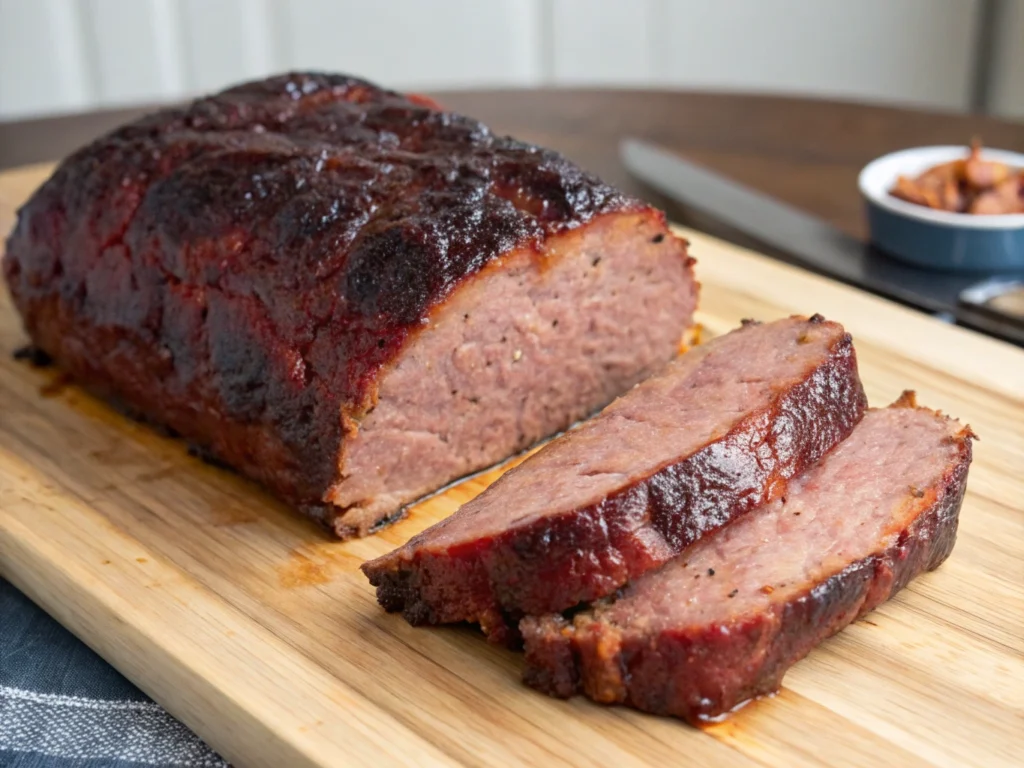
Structural Integrity
When your meatloaf falls apart:
- Problem: Meatloaf falls apart during smoking or slicing
- Solution: Allow meatloaf to rest fully before cutting (minimum 15 minutes)
- Solution: Ensure proper ratio of binding agents (eggs and breadcrumbs)
- Solution: Consider using a loaf pan for more support during cooking
Structural issues typically relate to binding problems or insufficient resting time.
Smoke Intensity Balance
When smoke flavor overwhelms:
- Problem: Overwhelming smoke flavor
- Solution: Use milder wood varieties for longer cooks
- Solution: Create a barrier by brushing exterior with oil before smoking
- Solution: Consider “hybrid cooking” – smoke for 2 hours then finish in oven
Finding your ideal smoke level takes experimentation—your preference might differ from others.
Temperature Milestones and Timing Guidelines
Understanding what happens at different internal temperatures helps you monitor progress:
| Internal Temperature | Stage | Notes |
|---|---|---|
| 125°F | Early stage | Smoke flavor developing, structure forming |
| 145°F | Halfway point | Apply first layer of glaze |
| 155°F | Near completion | Apply final glaze layer |
| 160°F | Target doneness | Safe consumption temperature, optimal juiciness |
| 165°F+ | Well done | Firmer texture, potential moisture loss |
Remember that carryover cooking continues during rest time—removing your meatloaf at 160°F ensures it won’t overcook while resting.
Serving Suggestions for Smoked Meatloaf
Complement your centerpiece with thoughtfully chosen sides.
Classic Pairings
Traditional accompaniments that never disappoint:
- Garlic mashed potatoes with smoked meatloaf drippings
- Roasted seasonal vegetables with herbs
- Crisp garden salad with vinaigrette
- Homemade dinner rolls for sopping up juices
Classic sides provide familiar comfort alongside your reinvented meatloaf.
Modern Interpretations
Creative serving ideas for contemporary tastes:
- Smoked meatloaf sliders on brioche buns
- Meatloaf tacos with pickled onions and cilantro
- Grilled meatloaf sandwich with caramelized onions
- Smoked meatloaf hash with fried eggs for brunch
Leftovers transform beautifully into these innovative presentations.
Make-Ahead and Storage Tips
Maximize convenience without sacrificing quality.
Preparation Options
Streamline your cooking day:
- Assemble raw meatloaf mixture up to 24 hours in advance (refrigerate)
- Shape loaf and refrigerate overnight for enhanced flavor melding
- Mix dry ingredients separately from wet for quick assembly day-of
Many pitmasters find that overnight refrigeration actually improves flavor development.
Leftover Management
Enjoy your creation for days:
- Refrigerate smoked meatloaf up to 4 days in airtight container
- Freeze sliced portions for up to 3 months in vacuum-sealed bags
- Reheat slices in skillet with small amount of beef broth to maintain moisture
- Crumble leftovers as starter for chili or pasta sauce
Proper storage preserves both texture and flavor for future meals.
Variations on Classic Smoked Meatloaf
Once you master the basic technique, explore these creative adaptations.
Global Flavor Profiles
Take your tastebuds traveling:
- Southwest: Add chipotle peppers, corn, black beans, and top with salsa
- Italian: Incorporate sun-dried tomatoes, basil, mozzarella center, marinara glaze
- Asian: Mix in lemongrass, ginger, soy sauce, water chestnuts, and hoisin glaze
- Southern BBQ: Include chopped pickles, BBQ seasoning rub, and bourbon glaze
These variations maintain the smoking technique while introducing exciting new flavor combinations.
Dietary Adaptations
Adjust for specific nutritional needs:
- Low-carb: Substitute pork rinds or almond flour for breadcrumbs
- Gluten-free: Use certified gluten-free oats or crushed rice cereal as binder
- Dairy-free: Replace milk with stock and omit cheese or use nutritional yeast
- Leaner option: Use 90/10 beef with ground turkey, add olive oil for moisture
These modifications ensure everyone can enjoy your signature smoked meatloaf.
Expert Tips for Smoked Meatloaf Success
Small details yield significant improvements.
Preparation Insights
Elevate your technique:
- Mix ingredients by hand just until combined – overmixing leads to density
- Sauté vegetables before adding to mixture for mellower flavor
- Test seasoning by cooking a small patty before committing to full loaf
- Form a slightly indented trough along the top to hold glaze during cooking
These professional touches distinguish exceptional smoked meatloaf from merely good versions.
Smoking Techniques
Master the smoking process:
- Create a foil sling for easy removal from smoker
- Consider free-form loaf for maximum smoke penetration
- Use loaf pan for first half of cooking, then remove for bark development
- Rotate meatloaf halfway through cook time if smoker has hot spots
Your technique will evolve with experience—experimentation leads to your personal perfect method.
Nutritional Information and Serving Size
Understanding the nutritional profile helps you incorporate this dish appropriately:
| Nutrient | Amount per Serving | % Daily Value |
|---|---|---|
| Calories | 385 | – |
| Protein | 29g | 58% |
| Total Fat | 24g | 31% |
| Saturated Fat | 9g | 45% |
| Cholesterol | 145mg | 48% |
| Carbohydrates | 12g | 4% |
| Fiber | 1g | 4% |
| Sodium | 765mg | 33% |
*Based on 8 servings per meatloaf using standard recipe
While not low-calorie, smoked meatloaf delivers substantial protein and relatively low carbohydrates compared to many main dishes.
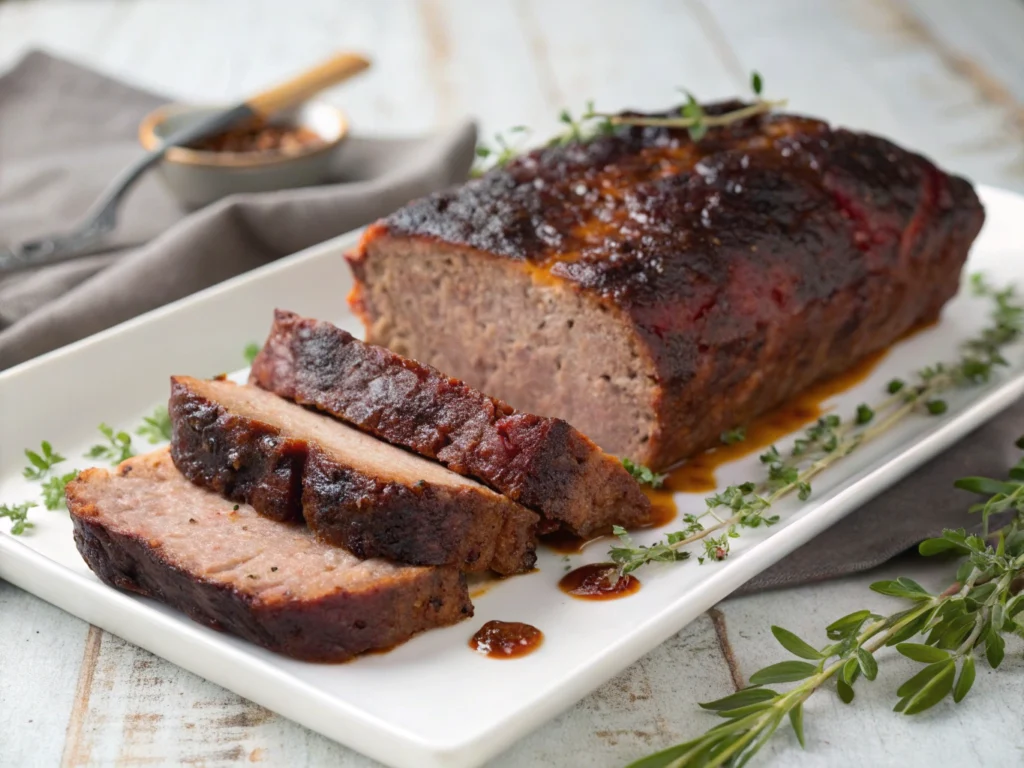
Frequently Asked Questions About Smoked Meatloaf
Q: What’s the best type of smoker for making smoked meatloaf?
A: While any smoker can produce excellent results, pellet smokers offer the most consistent temperature control for beginners. Traditional offset smokers impart the strongest smoke flavor but require more attention. Electric smokers are convenient but produce a milder smoke profile. The key is maintaining a consistent temperature around 250°F, regardless of smoker type.
Q: How can I tell when my smoked meatloaf is done without a thermometer?
A: While a thermometer is strongly recommended for food safety and optimal results, experienced cooks can look for these signs: the meatloaf should feel firm but slightly springy when pressed, the exterior should have darkened considerably, and any juices should run clear, not pink. However, these visual cues are less reliable than confirming the internal temperature has reached 160°F.
Q: Can I smoke a frozen meatloaf?
A: It’s not recommended to smoke meatloaf from a frozen state. The exterior would be exposed to smoke much longer than necessary while waiting for the interior to thaw, resulting in an overpowering smoke flavor and potential food safety issues. Always thaw your meatloaf completely in the refrigerator before smoking.
Q: How do I prevent my smoked meatloaf from being too smoky?
A: Control smoke intensity by choosing milder woods like apple or cherry, ensuring proper airflow in your smoker, using dry wood (excessive smoke comes from smoldering, not clean combustion), and considering a “hybrid method” where you smoke for only 1-2 hours before finishing in a conventional oven.
Q: Why does my smoked meatloaf split or crack during cooking?
A: Splitting usually occurs from rapid temperature changes or moisture loss. Bring the meatloaf closer to room temperature before smoking, ensure adequate fat in your meat mixture, consider adding a water pan to your smoker for humidity, and avoid opening the smoker frequently, which causes temperature fluctuations.
Conclusion: Elevating Comfort Food to Culinary Art
The journey from traditional oven-baked meatloaf to this mind-blowing smoked version represents more than just a cooking technique—it’s a transformation that honors tradition while embracing innovation. By harnessing the ancient art of smoking, you’ve elevated a humble family staple into something truly remarkable that will have friends and family raving.
The beauty of smoked meatloaf lies in its accessibility—even smoking novices can achieve impressive results with this forgiving recipe, while experienced pitmasters can experiment with wood combinations and flavor profiles to make it uniquely their own. The process itself becomes a rewarding ritual, from the methodical preparation to the hours of anticipation as tantalizing aromas fill your backyard.
Beyond the incredible flavor development, there’s something deeply satisfying about reclaiming this classic American dish from its sometimes maligned reputation. Your smoked meatloaf stands as proof that with thoughtful technique and quality ingredients, even the most familiar foods can surprise and delight us anew.
Whether this becomes your signature dish for gatherings, a weekend smoking project, or a new family tradition, one thing is certain—once you’ve experienced the incomparable depth and character of properly smoked meatloaf, the oven version will forever pale in comparison.
Ready to transform your meatloaf experience? Fire up your smoker this weekend and prepare to amaze yourself and anyone lucky enough to share your table. Then, come back and share your results in the comments below! Did you try any wood combinations or special glazes? We’d love to hear how your smoking journey unfolds.
Have you given our recipe a try?
There are no reviews yet. Be the first one to write one.
